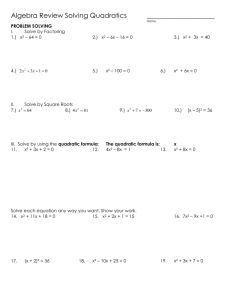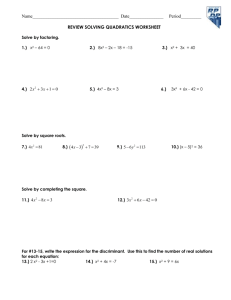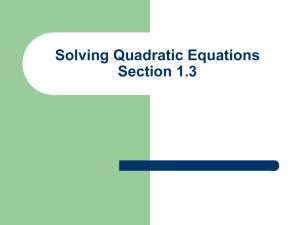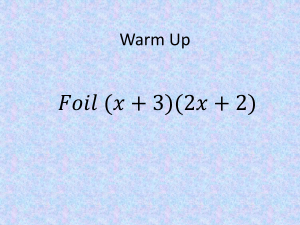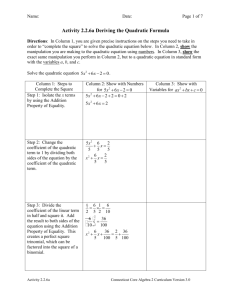Activity 2.2.3 Solve Equations by Factoring
advertisement
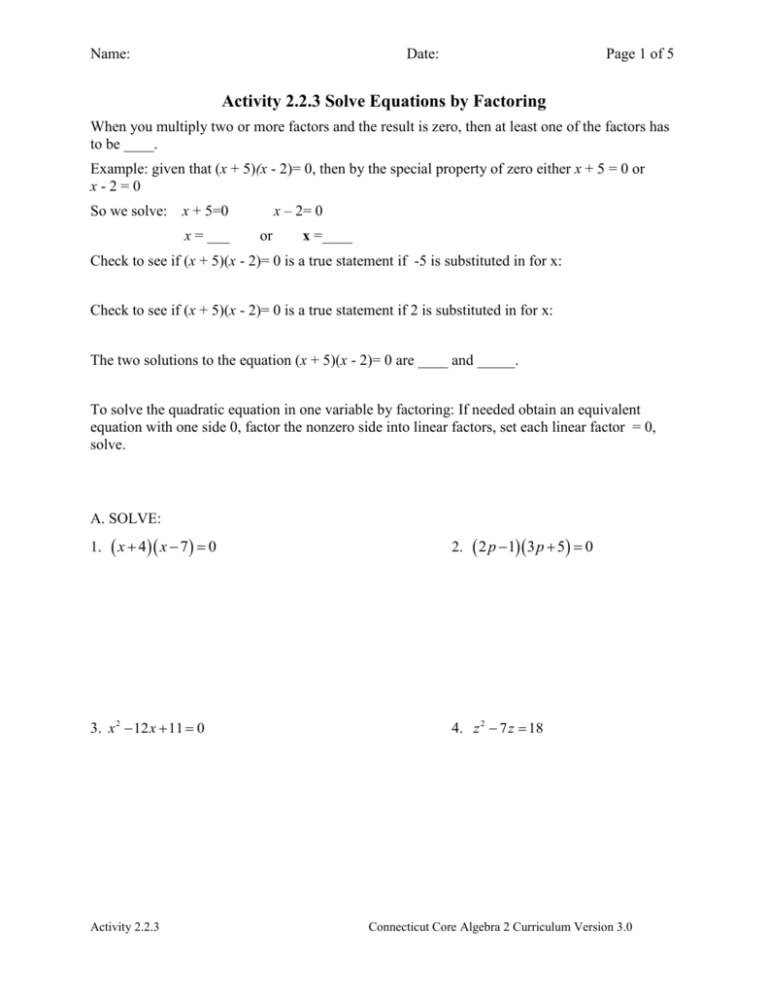
Name: Date: Page 1 of 5 Activity 2.2.3 Solve Equations by Factoring When you multiply two or more factors and the result is zero, then at least one of the factors has to be ____. Example: given that (x + 5)(x - 2)= 0, then by the special property of zero either x + 5 = 0 or x-2=0 So we solve: x – 2= 0 x + 5=0 x = ___ or x =____ Check to see if (x + 5)(x - 2)= 0 is a true statement if -5 is substituted in for x: Check to see if (x + 5)(x - 2)= 0 is a true statement if 2 is substituted in for x: The two solutions to the equation (x + 5)(x - 2)= 0 are ____ and _____. To solve the quadratic equation in one variable by factoring: If needed obtain an equivalent equation with one side 0, factor the nonzero side into linear factors, set each linear factor = 0, solve. A. SOLVE: 1. x 4 x 7 0 3. x 2 12 x 11 0 Activity 2.2.3 2. 2 p 13 p 5 0 4. z 2 7 z 18 Connecticut Core Algebra 2 Curriculum Version 3.0 Name: 5. 6k 2 13k 5 Date: Page 2 of 5 6. m 2 m 1 12 Solve each equation by factoring, if possible. If not factorable over the integers, write “trinomial is prime”. 7. 𝑑 2 + 6𝑑 + 9 = 0 8. 3(𝑥 2 + 7𝑥 − 1)+5=2(x+1) 9. c 2 5c 7 10. 5 x 2 13x 6 Activity 2.2.3 Connecticut Core Algebra 2 Curriculum Version 3.0 Name: 11. 9𝑥 2 − 16 = 0 Date: Page 3 of 5 12. 3x 2 4 x 8 13. Here are two quadratic equations that cannot be solved by factoring over the integers. One equation has no real number solutions. The other equation has two irrational, real solutions. Which one is which? Justify your answer. a. 𝑥 2 + 𝑥 − 1 = 0 b. 𝑥 2 + 𝑥 + 1 = 0 B. Now, let’s work backwards. If you are given the answers to a quadratic equation, how can you find the equation? Suppose the solutions to a quadratic equation are 2 and -5. What does a quadratic equation look like just before you find the solutions? ______________________________________________________________________ How does that become a quadratic equation? __________________________________ Is there another equation that has the same solutions?______________________ Write a quadratic equation first in factored form, then multiply out to obtain a quadratic with integral coefficients in the form ax 2 bx c 0 with the given solutions. 14. x 4, 7 Activity 2.2.3 15. x 2 ,6 3 Connecticut Core Algebra 2 Curriculum Version 3.0 Name: 16. x 0, Date: 4 5 Page 4 of 5 17. 𝑥 = −2, 𝑎𝑛𝑑 − 2 C. Mixed Practice: solve the following linear and quadratic equations: 18. 2m 2 14m 20. 22. f 5 f 1 f 3 f 7 2𝑥 2 + 3𝑥 − 11 = 2(𝑥 − 1)(𝑥 + 1) Activity 2.2.3 19. 2r+64=16r 21. 𝑟 2 − 64 = 0 23. r 2 64 16r Connecticut Core Algebra 2 Curriculum Version 3.0 Name: Date: Page 5 of 5 24. If the two solutions of a quadratic equation are 5 and -7, what is an equation with those solutions? D. Summary: 1. How can you tell if an equation in one variable is linear or quadratic? _______________ a. After simplifying, a linear equation has a degree of ______ and will have _______ solution(s). b. After simplifying, a quadratic equation has a degree of _______ and will have at most ______ solution(s). 2. How do you solve a linear equation in one variable? 3. How do you solve a quadratic equation in one variable using the factoring method? Activity 2.2.3 Connecticut Core Algebra 2 Curriculum Version 3.0
